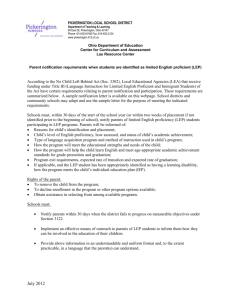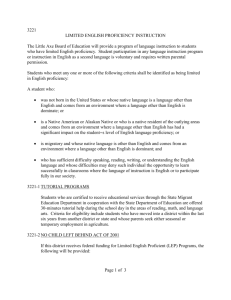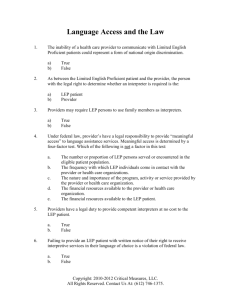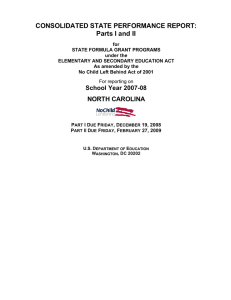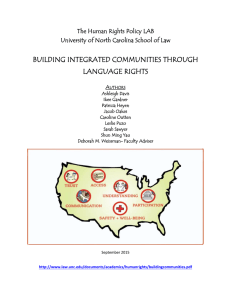F education standards, requirements and best practices, contact K Ballard at
advertisement
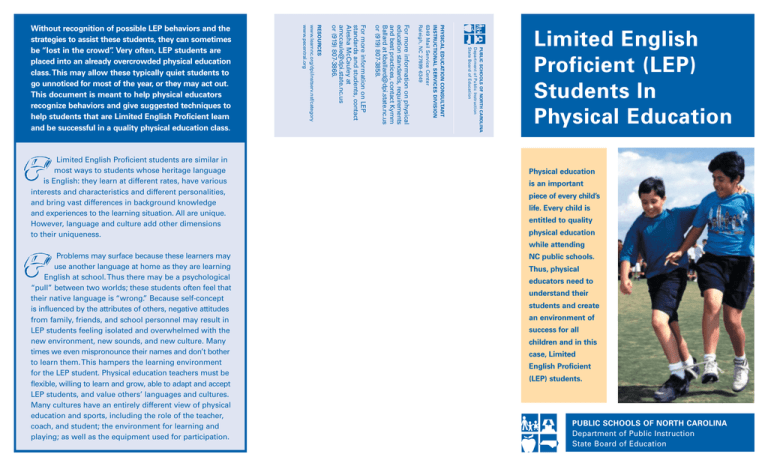
PUBLIC SCHOOLS OF NORTH CAROLINA Department of Public Instruction State Board of Education PHYSICAL EDUCATION CONSULTANT INSTRUCTIONAL SERVICES DIVISION 6349 Mail Service Center Raleigh, NC 27699-6349 For more information on physical education standards, requirements and best practices, contact Kymm Ballard at kballard@dpi.state.nc.us or (919) 807-3858. For more information on LEP standards and students, contact Alesha McCauley at amccaule@dpi.state.nc.us or (919) 807-3866. Limited English Proficient students are similar in most ways to students whose heritage language is English: they learn at different rates, have various interests and characteristics and different personalities, and bring vast differences in background knowledge and experiences to the learning situation. All are unique. However, language and culture add other dimensions to their uniqueness. RESOURCES www.learnnc.org/dpi/instserv.nsf/category www.pecentral.org Without recognition of possible LEP behaviors and the strategies to assist these students, they can sometimes be “lost in the crowd”. Very often, LEP students are placed into an already overcrowded physical education class.This may allow these typically quiet students to go unnoticed for most of the year, or they may act out. This document is meant to help physical educators recognize behaviors and give suggested techniques to help students that are Limited English Proficient learn and be successful in a quality physical education class. Limited English Proficient (LEP) Students In Physical Education Physical education is an important piece of every child’s life. Every child is entitled to quality physical education while attending Problems may surface because these learners may use another language at home as they are learning English at school. Thus there may be a psychological “pull” between two worlds; these students often feel that their native language is “wrong.” Because self-concept is influenced by the attributes of others, negative attitudes from family, friends, and school personnel may result in LEP students feeling isolated and overwhelmed with the new environment, new sounds, and new culture. Many times we even mispronounce their names and don’t bother to learn them. This hampers the learning environment for the LEP student. Physical education teachers must be flexible, willing to learn and grow, able to adapt and accept LEP students, and value others’ languages and cultures. Many cultures have an entirely different view of physical education and sports, including the role of the teacher, coach, and student; the environment for learning and playing; as well as the equipment used for participation. NC public schools. Thus, physical educators need to understand their students and create an environment of success for all children and in this case, Limited English Proficient (LEP) students. PUBLIC SCHOOLS OF NORTH CAROLINA Department of Public Instruction State Board of Education PHYSICAL EDUCATION TEACHING STRATEGIES This list is not meant to be a complete list or indicate that all LEP students are progressing in language development in the same way and at the same rate. Each student is unique, and physical educators will need to consider the needs of each student individually. WHAT YOU MAY SEE As LEP students begin to learn English, they may: • • remain silent; depend on body language, gestures, or paralanguage (words or phrases such as “huh?,” “unh-unh,” and “uh-oh” usually accompanied by a facial expression and/or gesture); • • • • • be actively listening as they silently translate; misinterpret body language or gestures and even directions; have limited school experiences (do not participate in much outside of the class); exhibit extremes of behavior: frustration, nervousness, fear, and self-consciousness. As LEP students progress to intermediate level in English language skills, they may: • • make unsystematic and random language errors that may lead to misunderstanding; exhibit social language skills in English that exceed language abilities necessary for academic success; • • exhibit limited but continuing progress in vocabulary, control of sentence structure, ability to read with comprehension, and ability to express ideas; generate language to ask and answer questions without being able to expand or explain; • • At the beginning level, teachers may: • require an extended period of time to translate information. As LEP students move into advanced level of language development and learning, they can begin to apply reading and writing skills to acquire information in academic areas and in real-life situations. These students may: • To support physical education teachers in choosing effective strategies to use in working with limited English proficient students in their classes, the following suggestions are provided. It is important to remember that strategies may be introduced, extended, and expanded at all levels according to the interests and abilities of the learners. frequently choose to use more that one language to communicate; exhibit oral fluency but still lack higher level, contentspecific language and writing skills; • make inaccurate inferences from cultural, linguistic, and intellectual experiences. provide opportunities for students to hear and practice language in context with others. This may best be done in stations at first with a buddy or mentor. set reachable goals and expect students to be accountable; 1. knowledge of language development and language acquisition; • encourage students to ask questions to clarify their understanding; • obtain background information about language and culture to avoid embarrassing situations; 2. the ability to adapt physical education content to students’ needs and levels of learning; 3. a willingness to learn about cultural differences and similarities; • speak clearly and at a normal pace with normal stress and intonation; check for understanding, as early clarification paves the way for success; present key words and ideas orally, demonstrate skills or use other visual aids before introducing a new concept or skill; 6. a belief that everyone learns from mistakes and from one another; use diaries, journals, picture collages, or posters in the PE setting. Understanding and being sensitive to the needs of students who are learning English as a second language is important. These students may know very little about American sports or skills, so physical education teachers should not assume so. Using effective strategies to support them as they learn physical education will help ensure an environment that will provide successful experiences for LEP students. • involve parents and community members; cultural exchange builds understanding. You can also provide pictures, games and decorations that embrace the countries represented. It can be an integrated learning activity; • provide opportunities (like games) for students to learn and respond to the usual directions, for example, “raise your hand” or “get into squads”; ask students to explain what they have seen or read and where they have seen these skills or situations; this provides opportunities for integration and oral expression. • provide a learning buddy or mentor for demonstration and assistance; • • Generally teaching LEP students requires: • categorize words and ideas, which provide “hooks” for learning so that when you speak, you can emphasize these words. Have key words posted in two languages; use cooperative learning groups and partners when learning a new skill or game to demonstrate; At the intermediate level, teachers may: • • use repetition and consistency in instruction and gestures and possibly skill development. • • At the advanced level, teachers may: • provide examples when making assignments for homework, activity, rules of a game, and research assignments; a visual goal helps with understanding; 4. flexibility and sensitivity; 5. a philosophy that learning takes place in every situation and every environment; 7. an encouraging, nurturing attitude
